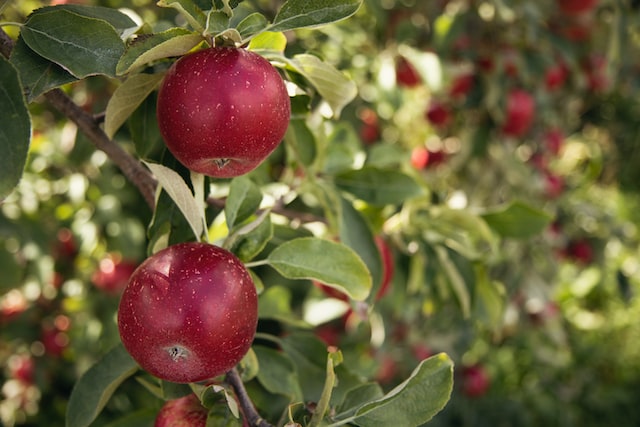Apple Scab on Leaves and Fruit – Venturia inaequalis, also known as apple scab, is the most important and harmful apple disease both worldwide and in our region. The occurrence of this disease reduces the quantity and quality of the yield. Since apples are the most important fruit species in Croatia in terms of intensive cultivation, disease and pest protection annually costs between 8,000 and 10,000 kunas, which constitutes a quarter of the total costs. Half of the control costs are attributed to apple scab alone. In fact, almost the entire apple protection program is tailored to combat this disease. On average, treatment is carried out about 15 to 20 times a year.


Disease attacks
The disease attacks the leaves and fruit, less frequently the young shoots and flowers.
Causative Agent
The fungus Venturia inaequalis.
Symptoms of the disease
Biology of Apple Scab
The fungus overwinters in two ways. On heavily infected trees, the fungus overwinters as mycelium or conidia on the bark, between bud scales, or in depressions on small branches. In mild winters, conidia can develop from mycelium as early as February, causing infection on young leaves with the help of rain and wind, even during the bud swelling stage. The optimal temperature for conidia germination is around 16°C with a relative humidity of 90%.
The other way is when with the autumn leaf fall, the fungus transitions into its winter stage of perithecia (fruiting bodies) containing asci with 8 ascospores. Perithecia mature in spring (March, April, May) depending on climatic conditions. Not all perithecia mature simultaneously but over an extended period. It’s important to note that perithecia maturation coincides with the phenophases of bud swelling and opening. The optimal temperature for ascospore formation is around 4°C.
For perithecia to mature, eject ascospores onto leaves or buds, and initiate infection, rain is necessary. If there isn’t enough rain, perithecia won’t eject ascospores, meaning mature ascospores can be present in the orchard without causing infection until rainfall occurs. Heavier rain causes perithecia to swell, and due to the pressure on the membrane, ascospores start ejecting actively into the air, reaching distances of 1 to 2 cm. A light breeze can then carry them over greater distances, facilitating primary infection.
The severity of infection and the speed of incubation depend on the duration of leaf wetness and temperature. For instance, at a temperature of 15°C, the leaf needs to remain wet for 9 hours for a mild infection, 13 hours for a moderate infection, and 20 hours for a severe infection (Prof. I. Ciglar).
Conditions necessary for infection
I. PRIMARY INFECTION
Damage caused by the disease
The fruit remains underdeveloped and later develops cracks on its skin. Young apple leaves are the most sensitive, and symptoms of infection are first observed on them.
Protection against apple scab
Young leaves are most susceptible to the causative agent of this disease, so preventive treatment is recommended in the early stages of development to reduce the risk of disease occurrence. For initial protection against apple and pear scab, preference is given to the application of various copper fungicides (e.g., Nordox, Kocide, Champion, Cuprablau-Z, Champ F2). Before flowering, different organic fungicides are used (e.g., dithianon, pyrimethanil, cyprodinil, mancozeb), and during flowering, strobilurins (Stroby DF, Zato WG) are employed. (Be sure to check the FIS register for available plant protection products.)


It is also recommended to use fungicides such as Chorus 75 WG, Delan 700 WDG, Chromodin S-65, and Stroby WG. These fungicides should be applied starting from the “mouse ear” stage of apple and pear development, using a block method with two consecutive sprays. Spray intervals depend on weather conditions and range from 5-7 days. (Be sure to check the FIS register for available plant protection products.)
If primary infections and disease onset (typically by the end of June) have not occurred, the risk of apple scab appearing in summer is very low. This is attributed to low rainfall, high temperatures, and the absence of fruiting and secondary infections. At that point, disease control is maintained through scheduled spraying at intervals of 10 to 20 days using preventive fungicides.
As apples mature, they become increasingly resistant to apple scab.
Sensitive apple varieties such as Golden Delicious, Gloster, Mutsu, Gala, Braeburn, Granny Smith, and others have recorded complete crop losses, with losses reaching 100% due to apple scab.
There is one important difference in pear compared to apple, which is crucial for protection. The apple scab mycelium in pears overwinters in the bark of young branches, from which conidia develop early in spring. This can result in fruit becoming infected during initial development. Therefore, it is recommended to protect young fruit during the earliest stages of development.













































